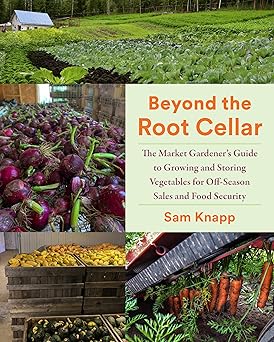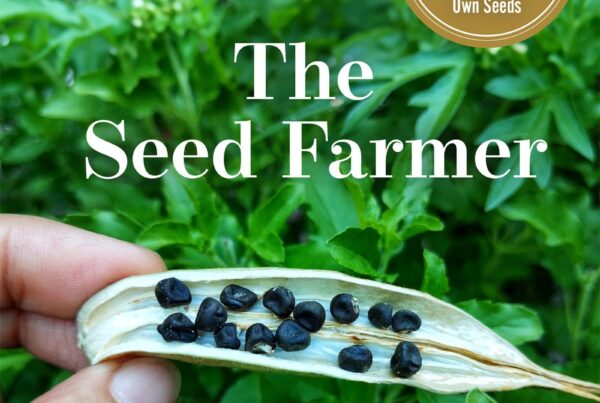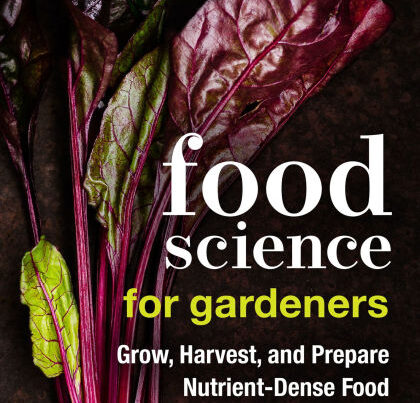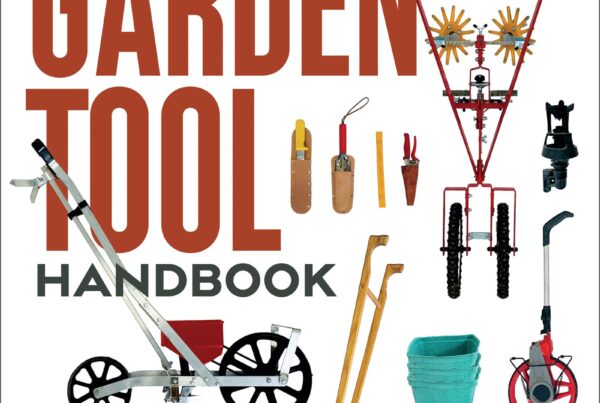Book Review by Pam Dawling, Author of Sustainable Market Farming: Intensive Vegetable Production on a Few Acres, and The Year-Round Hoophouse: Polytunnels for All Seasons and All Climates
Beyond the Root Cellar: The Market Gardener’s Guide to Growing and Storing Vegetables for Off-Season Sales and Food Security
Sam Knapp, 2024, 272 pages, 8 x 10 inches. $45.
Chelsea Green Publishing
I have been looking forward to this book, because I appreciated several articles by Sam Knapp in
Growing for Market magazine. This book addresses a gap in most local food systems. It is the
first (only) book of this kind, and it’s very good. Sam Knapp is a pioneer.
Sam worked as an engineer before becoming a farmer in the Michigan Upper Peninsula, and then
in Fairbanks, Alaska, where he runs a winter-only CSA from Offbeet Farm and sells to local
groceries. Thanks to his scientific background, he understands and explains energy efficiency, as
well as spreadsheets, very well.
This book will up your game in storing winter vegetables, as it includes the vital information on
choosing, growing, harvesting, trimming, processing, curing (if needed) and storing eighteen
crops, as well as details about constructing storage spaces and operating climate-control systems.
The author has considered lots of sources of information, and when information conflict, he has
presented the experience of farmers, and the results of scientific trials and studies. There’s plenty
of useful info for small scale growers not on the point of building big storage buildings. Anyone
growing any storage vegetables will get valuable information.
North American countries could use a lot more locally grown winter crops. There is not much
competition yet. A storage farmer wanting to also provide training for apprentices, or other ways
of training, would be offering a rare commodity.
Storage crops offer a lifestyle of intense large-scale work in the fall, followed by a “selling
season” with reduced or no outdoor work. Storage crops take a little time to plant and tend
during summer, leaving lots of the week open for other activities. The work flow is less likely to
cause burnout than farming for summer and fall sales.
The first part of the book (about 60 pages) is From Field to Storage. Here we learn about
choosing appropriate crops and varieties, recognizing maturity, harvesting, post-harvest handling
and putting the produce into storage. The author’s father Phil spent many weeks of his retirement
taking the photos for the book, as well as helping with construction work. The uncorrected proof
I am reviewing has the photos rendered in greyscale, such is the lot of reviewers!
Some vegetable crops increase their cold-hardiness as daylight and temperature decrease by
producing sugars and alcohols in their cells, lowering the freezing point of the sap. Others
transition to a state of reduced metabolic rate, activated by plant hormones or low temperatures.
There are two kinds of dormancy: hormonally controlled dormancy and environmentally
controlled dormancy. The latter crops will sprout if exposed to warm temperatures and moisture.
Crops with hormonally controlled dormancy will not resprout until triggered by a change of
hormones, often due to cumulative exposure. Aha! New information for me. Which crops are
which? Sweet potato dormancy is environmentally controlled. Any extended exposure to
moisture and temperatures above 60F (15.5C) leads to sprouting. Potatoes, on the other hand, can
stay dormant for months even if exposed to good growing conditions. Onion sets are an example
of dormancy maintained by environmental conditions – temperatures above 85F (29C), and dry.
Onion sets when planted in cool spring conditions, grow into larger onions.
Choose crops that reliably mature in your area. The number of frost-free days, soil temperatures
and daylength can all affect maturing. Did you know that Butternut squash requires darkness to
set fruit? Avoid crops or varieties that easily bolt, split, break, or bruise, or are susceptible to rots.
Read the small print in the seed catalogs. Collect your own data, perhaps on your phone. The
book has some tips and a Variety Trial Datasheet. Record storable yield per area, as well as culls
as a percentage of total yield.
The next chapter is about harvest. As this is going to be a major part of the farm work, Sam
advocates careful harvest planning. There are charts in the book to help you track progress.
Consider your last date for harvesting each crop, and the amount of time the harvest could take.
Make sure not to plant more than you can harvest in the window! Make use of any past harvest
records you have. Ask nearby vegetable growers too. Can you harvest 10 100ft x 5ft beds of
cabbage in just over one day? How many days do you need to allocate to carrots? Can 2 people
hand-harvest 900lbs of carrots in 8 hours?
Past climate data are helpful. The National Weather Service has a Past Weather page. (I like
Weatherspark myself.) Look for daily normal, average high, low and mean temperatures for each
day at that time of year. Plan to harvest before the date when the mean temperature reaches the
threshold for chilling injury of that crop. It may well be earlier than you had expected.
Remember to factor in some days for bad weather! Add rowcover or mulch in the fields if you
need to buy time. Watch the crops and triage if necessary. This means three categories: crops it’s
imperative to harvest, ones you must let go of, and ones to harvest if at all possible.
Garlic and onions will most likely be first, and are very prone to troubles if left too long in the
field. Cold-sensitive crops are next: winter squash, pumpkins and sweet potatoes. These all
accumulate chilling injury below 50F (10C), leading to deterioration in storage. Next are the
crops that are damaged by hard frosts: cabbage, kohlrabi, rutabagas, turnips, winter radishes,
beets, celeriac, potatoes. Beets lead this group. The final group includes crops least damaged by
hard frosts: carrots, parsnips, sunchokes, leeks.
Try not to be Nervous Nellie, harvesting sooner than necessary: many crops develop better
flavors in colder weather. Also consider the extra electricity you’d use for cooling for longer.
Common advice sets 28F (-2C) as the limit for intermediate crops such as beets, and 24F (-4C)
for the most cold-hardy crops. The duration of cold temperatures as well as the daily mean, (and
therefore the high temperature that day) are important parts of the equation.
There is some discussion of harvesting equipment, from knives to the intriguing Scott Viner
harvester, which runs a digging shoe below a row of roots such as carrots, at the same time as a
set of rubber belts grabs the carrot tops just above the crowns, and lifts them up, dangling by
their tops. Next there is a knife that cuts the tops and deposits the carrots onto a chain conveyor,
shaking soil off as it goes. The carrots are dropped into a following truck or wagon. A fast hand-
worker can harvest 200-250lbs carrots per hour on a clean bed that has been undercut. A Scott
Viner with 3 or 4 workers to tend it, can harvest 2,500 to 3,000 lbs per hour. Dryish soil is
needed.
Harvest-handling equipment consists of containers and compatible equipment to move the filled
containers. Carts and wheelbarrows can move about 200 pounds of well-balanced crops.
Containers are generally either small enough to lift by hand or large enough to need a forklift.
When considering upgrades, decide your handling equipment first, and get containers that fit
with those.
After harvesting, the crops generally need attention before storing: trimming, washing, curing,
grading. There are several reasons for trimming root crops. Most leaves will rot in storage
anyway, so they have no future. Trimming saves storage space, makes washing easier, and
reduces moisture loss. Ideally, leave only short stubs of the leaf stems, which will dry out quickly
and are unlikely to rot. If the trimming can be done in the field, all the inedible organic matter of
that crop returns to the soil, plus you have less to haul away.
Potatoes and sweet potatoes must be cured, a process when cut surfaces heal over and become
coated by a protective waxy layer. Cured skins become more firmly attached to the tubers,
preventing further damage.
There is discussion on whether to wash root crops before storage. It depends on the equipment
you have. With electricity, washing pre-storage is a viable option. Without it, conserve moisture
in the veggies by leaving the soil on them. If you have cooled storage, you may prefer to wash
veggies while the weather is warm, and the soil is easier to remove. Barrel washers are
discussed, including farm-made ones, both hand-cranked and electrically powered, and
purchased small-scale models.
Chapter 4 Into Storage contains lots of useful tips. In the first few weeks after you store the
crops, they need attention to ensure conditions are right, and removal of vegetables that are
starting to rot. You can’t sort through large amounts, but cast an eye over the top layer. Sam
divides crops into four groups according to optimal storage conditions. He acknowledges that
you might have to compromise if you can’t provide the ideal for everything.
The cold and damp group (32F, over 98% humidity) works well for most winter storage crops,
especially roots and leafy crops. Alliums do best at 32F and 60-70% humidity, fairly cold and
fairly dry. Compromise on the temperature, not the humidity! Avoid 40-50F for garlic, and 50-
86F for onions. Potatoes do best at 38-45F and above 95% humidity, as temperatures below 38F
can cause chilling injury, leading to browning of the flash when cooked, especially fried. Higher
temperatures lead to faster sprouting. Sweet potatoes are best at 57-60F and 85-90% humidity,
and colder temperatures lead to chilling injury; higher ones to sprouting. Winter squash and
pumpkins do best at 50-55F and 50-70% RH: higher temperatures lead to shriveling and
yellowing of green varieties; chilling injury shows as pitted skin.
Choose storage containers that allow airflow, can stack, are not too heavy. Large farms use
palletized containers. There are plastic macrobins, farm-made wood bins and cardboard Gaylord
boxes with wood pallet bases. There are woven super sacks that fit on a pallet and can be lifted
with pallet forks using the large loops at the top. These are cheap but don’t stack unless put
inside a container such as an Intermediate Bulk Container (IBC) frame.
Alternatives are smaller containers such as 5-gallon buckets, plastic 18- and 27-gallon totes with
holes drilled in them, as well as 50lb grain bags. This chapter has a chart of bulk density of
storage crops, to help with planning. A 27-gallon tote can hold 95-110lbs of beets. Traditional
storage methods such as damp sand or sawdust are fine for a few hundred pounds of veggies, but
impractical for large quantities. Also, sawdust, burlap, wood shavings and peat moss can impart
their flavor to the vegetables.
Part 2 of the book (about 60 pages) covers designing structures and practices, including the
business side. Starting a storage farm does involve high up-front costs for buildings and
equipment, although it’s fine to start with the buildings you have. Efficiency, efficacy and scale
are important, because storage crops don’t generally sell for top prices, although on the plus side,
you will be selling into a relatively open market. Be sure to match the scale and costs of your
infrastructure and production with your likely sales. Small intensive farms (1-7 acres of storage
crops) with close crop spacing can produce high yields, such as 25,000lbs/acre. Average yields
are 10,000lbs/acre for larger mechanized farms.
This book provides up-to-the-minute details on modern construction and insulation materials. It’s
not a construction manual, more a technical decoding guide and a shopping advisor, providing
the overview you need to have useful conversations with contractors. Or perhaps to provide the
knowledge to embolden you to construct your own storage spaces.
There is help with estimating seasonal income and losses (there is are charts of shrinkage
estimates over various durations). There are suggestions on how to sell crops before the storage
losses become too high: figure out a percentage loss to accept, and if you still have produce at
that point, put it on sale! And adjust your plan to grow less of that crop next year. There’s an
excellent working example of squash loss. Note harvest weights, sales records, total losses, the
selling quality and the effectiveness of your sales strategies. Don’t neglect other goals and ethics.
Is your goal to maximize your income or to provide food for your community for as long as
possible?
Traditional root cellars are useful. If you are starting from scratch, compare with shipping
containers (either insulated or uninsulated and buried), walk-in coolers (used?), CoolBots,
purpose built above-ground insulated buildings, or cellars below other buildings. Your climate
will play a big role in choice of storage. Farmers with milder winters are able to manage with
less-insulated structures, as their heating and cooling use will be lower.
This section includes explanations of R-value (insulation), dewpoint, temperature, relative
humidity (RH), vapor barriers, various insulation materials, and which ones Sam recommends
for various situations. There are instructions to slope floors, deal with joins in sheet materials,
avoid thermal bridging, condensation and moisture transfer. Lots of help for those building their
own structures or instructing a contractor.
Climate control is covered very thoroughly and clearly. Having a good storage structure gets you
part way to your goal of keeping crops dormant while retaining moisture and limiting chilling
injury. Refrigeration and/or heating might be required. There’s help with calculations and costs
and choosing suitable equipment.
There’s a 3-page section comparing CoolBot (which uses AC technology) and commercial
refrigeration. CoolBot has a limited range of operating temperatures. This might be sufficient if
your climate is relatively mild, and you can use cold outdoor air most of the storage season.
CoolBots don’t work so well with outdoor temperatures below 25F. Oversizing the CoolBot for
the space or using multiple CoolBots in the same space will help with initial cooling of large
harvests. Commercial refrigeration units can cool spaces faster than CoolBots. Single-AC
CoolBot systems use less energy than refrigeration, but it’s unclear if multiple-AC systems do.
CoolBot has a good website and customer service.
There are recommendations on dehumidifiers and humidifiers, not forgetting the “put water on
the concreter floor” method. Good airflow is vital for achieving even conditions throughout your
storage space: consider fans and pulling in cold outside air.
Part 3 (about 46 pages) is the storage crop compendium, where the needs of 18 storage
vegetables are clearly described in precise detail, including responses to ethylene, and also
common problems. This is the section I’m going to use immediately. If this is the only part of the
book you need right now, buying the book is worth it! Sam has done a lot of sleuthing to compile
very specific information. His longest storage recommendation seems to be 4-6 months, although
longer is definitely possible in our climate.
The final section of the book (about 65 pages) offers profiles of nine storage farms from North
Carolina, Wisconsin, Washington, Michigan, Minnesota, Vermont, Manitoba and Alaska. Each
profile ends with a paragraph of advice for new storage growers. These profiles make a good
read, suggesting several workable systems, from ¼ acre improvised start-ups, through converted
barn root cellars and dairy barns supplemented with refrigerated trailers or shipping containers,
to purpose-built spaces on new farms requiring tree clearance or a set of walk-in coolers and
trailers. Land in storage crops is up to 7 acres (25 acres in one profile) of storage crops, mostly
grown on a bed system. Some use off-site rented storage. Most of the farms run CSAs and do a
lot of harvesting by hand. Some focus on 8 or fewer crops, others diversify as much as possible.
Some combine being a storage farm with growing summer crops, some specialize and some
combine with farm-related businesses such as a fermentation business.







